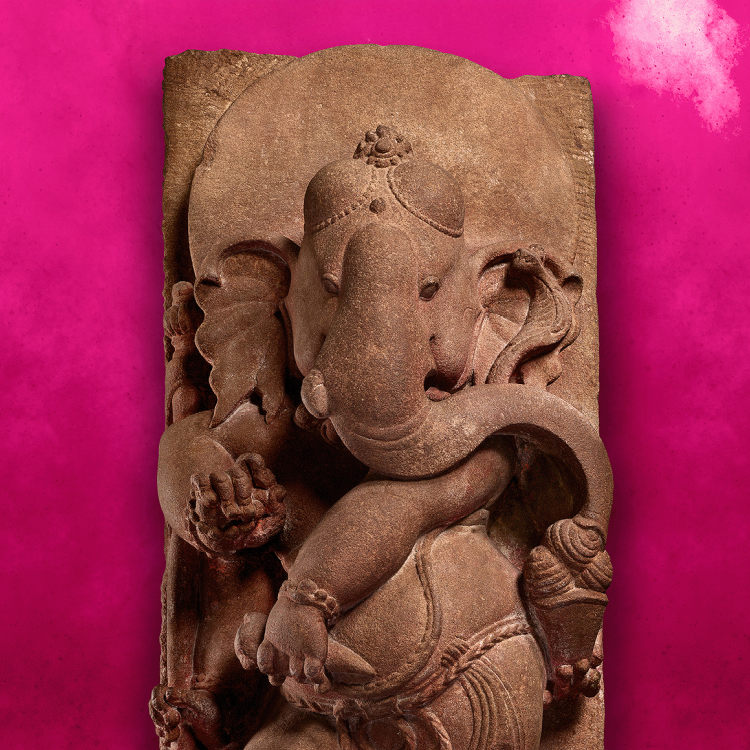See the exhibition
Ancient India: living traditions is open 22 May – 19 October 2025.
About this guide
This guide is written using short, easy to read sentences.
It can be used by anyone, including visitors with accessibility needs and non-English speakers.
This guide takes you on a tour of the exhibition.
It looks at 10 different pictures and objects.
A map of the exhibition shows you where to find them.
The exhibition has seven sections. There is an introduction to each section.
Each object has a number. These numbers are on the exhibition map.
The map shows you where each object is in the exhibition.
Please let us know what you think about this guide. Tell a member of staff or email [email protected]
A large print guide containing the entire exhibition text is also available.
Statue of a dancing god
1. Statue of a dancing god
This sandstone statue or sculpture is of a Hindu god called Ganesha.
He has the body of a human, but the head of an elephant and a snake tied around his waist.
The elephant and snake link Ganesha to a time when people worshipped nature.
Colourful painting of Lakshmi sitting on a lotus flower
2. Colourful painting of Lakshmi sitting on a lotus flower
Lakshmi is the goddess of good luck and plenty.
Here, elephants are pouring water over her. It represents the way that rain brings everything to life.
Hindus, as well as some Jains and Buddhists, worship Lakshmi.
Painting of the god Krishna
3. Painting of the god Krishna
Some nature spirits are snakes. They are as powerful as gods.
The Hindu gods had many battles with these snakes.
This painting shows the Hindu god Krishna defeating a snake king called Kaliya.
Snake protecting a Jain teacher
4. Snake protecting a Jain teacher
This sandstone sculpture is of a Jain teacher.
An evil spirit is trying to stop him meditating by making it rain.
The teacher's assistant is a snake nature spirit. He protects the teacher from the rain by using his snake hood like an umbrella. The photograph next to the object label highlights this.
Queen of snakes
5. Queen of snakes
Padmavati is a nature spirit and queen of snakes.
She is also the assistant of a Jain enlightened teacher.
People worship her because they believe she will protect them.
Different images of the Buddha
6. Different images of the Buddha
This stone carving has representations of the Buddha on both sides.
On this side, he is represented by a tree, an umbrella (or parasol), a throne and a set of footprints. The photograph next to the object label highlights these.
On the other side of this carving, made about 300 years later, the Buddha is a man.
Snake guarding a shrine
7. Snake guarding a shrine
Snakes are often carved on the outsides of shrines.
They protect the building and the people who visit.
This snake has 5 heads and is ready for action.
Introduction to Hindu art
Hinduism is the oldest continuously practised religion in India.
Hindus believe the spirits of the gods and goddesses live in their statutes, so look after them every day.
The gods and goddesses have different features that make them easy to recognise, such as the objects they hold.
The god who keeps people safe
8. The god who keeps people safe
This is Vishnu, one of the most important Hindu gods.
He has many different disguises on earth.
Here, he has the head of a wild pig and the body of a man.
A god and goddess team
9. A god and goddess team
The right side of this statue is a goddess.
The left side of this statue is a god.
The photograph next to the object label shows the different sides in detail.
When it was made, Hindus probably painted it in bright colours, dressed it in clothes and decorated it with garlands of flowers.
Introduction to Beyond India
Buddhism and Hinduism spread along trade routes to Southeast, Central and East Asia.
The Buddhists and Hindus in each new place made their own versions of the statues from India. They created new local styles.
They kept some original features, so believers from anywhere could recognise who the pictures and statues were meant to be.
The goddess of rice
10. The goddess of rice
This poster is from a country called Thailand.
Rice is an important food in Thailand, so some of the people worship the goddess of rice.
Here, she is holding a rice plant.





